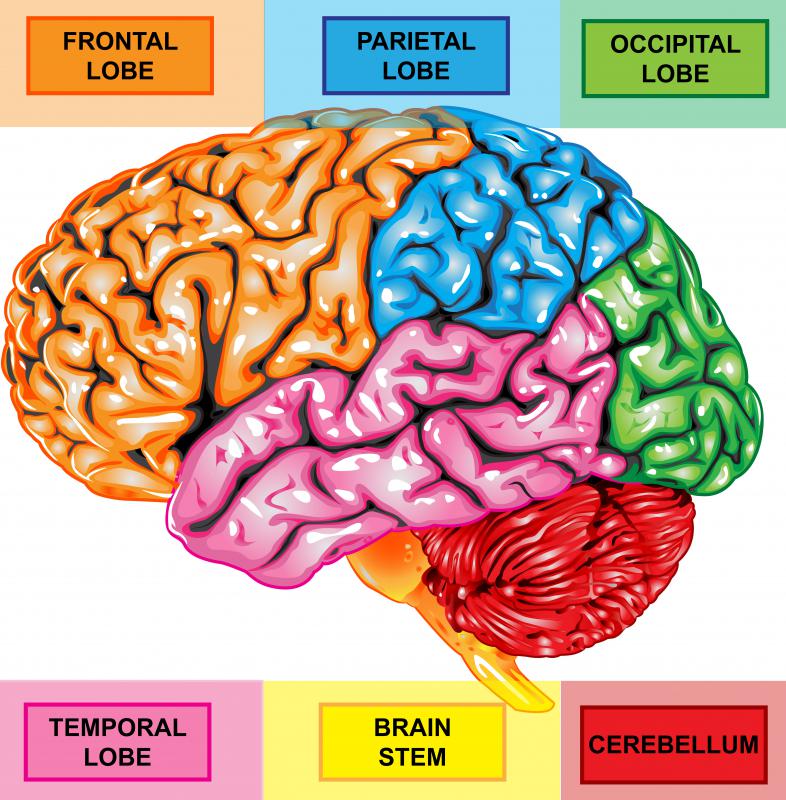At WiseGEEK, we're committed to delivering accurate, trustworthy information. Our expert-authored content is rigorously fact-checked and sourced from credible authorities. Discover how we uphold the highest standards in providing you with reliable knowledge.
What is the Cerebral Hemisphere?
The brain can be divided into two regions. The brainstem is the part of the brain extending downward toward the spinal cord. The cerebral hemispheres contain the wrinkled outer layer of the brain, called the cerebral cortex, and a few deeper structures including the basal ganglia, the hippocampus, and the amygdaloid nuclei.
A cerebral hemisphere is mainly made up of furrowed gray matter with an inner layer of white matter. The gray matter of the brain contains the neuron cell bodies. The white matter, on the other hand, is white because it contains the myelinated axons that extend from a neuron cell body. The crests of the gray matter wrinkles are called gyri, and the grooves are called sulci or fissures. The central sulcus is one of the most prominent sulci, which separates the precentral and postcentral gyri. The precentral gyrus is involved with motor functions, while the postcentral gyrus controls sensory input.

Each cerebral hemisphere can be divided into four lobes, each with distinct functions. The frontal lobe, which covers the area behind the forehead and the top of the head, is involved with planning and movement. The parietal lobe, located just behind the frontal lobe, manages sensory information. The occipital lobe at the base of the skull is involved with vision, and the temporal lobe, which lies on the side of the brain behind the ears, manages hearing.

The cerebral hemispheres control the contralateral sides of the body, meaning the right cerebral hemisphere controls the left side of the body and vice versa. Sensory information from the right hand, for example, crosses over to the left cerebral hemisphere, where it is processed. To move the right hand, the signal must come from the left side of the brain and cross over again.

A large bundle of nerves called the corpus callosum links the left and right cerebral hemispheres. The two hemispheres are not always exactly symmetrical, and they may be somewhat specialized. For example, Wernicke’s area and Broca’s area, the two parts of the brain involved in speech, are both located on the left cerebral hemisphere.
The deeper parts of the cerebral hemispheres are also critical to brain functioning. The basal ganglia, a collection of nuclei closely connected to the cortex, regulate motor movement. The hippocampus is involved with memory storage and retrieval. The amygdaloid nuclei controls emotional responses, especially to emotions like anger and fear.
AS FEATURED ON:
AS FEATURED ON:
















Discussion Comments
@bythewell - Actually our enlarged cerebral hemisphere might be responsible for our evolution in more ways than one.
You need a lot of energy to power such a big brain and scientists believe it might be the reason we started hunting meat rather than relying mostly on plants like our close relatives, the chimps (who will eat meat, but only when they have the opportunity, they don't usually hunt it down).
Which may have led to the development of language (requiring even bigger brains) because it is useful for coordinating attacks on prey.
@Mor - Our cerebral hemispheres are one thing that separates us from animals. Most animals have roughly the same ratio of brain stem to body weight that we do which might be why you've heard the brain stem be referred to as the "alligator brain".
But, we have a massive cerebral hemisphere in relation to body weight compared to other animals. I believe the dolphin has one approaching ours, but still not close.
Which, I guess, is one of the reasons we can talk to each other and create such a complex society.
I always heard it said that the brain stem was kind of like the "alligator brain" since it was responsible for things like breathing and digestion. Things which aren't really under complete conscious control.
While the cerebral hemisphere is responsible for everything else, including memory and emotion and logic and so forth.
And it is also more adaptable. So, if you happen to injure your cerebral hemisphere, there's a good chance you'll be able to recover. Even what might seem like massive injury can still be, if not repaired, then worked around as the cerebral hemisphere can put other parts to work.
However, if you get severely injured in your brain stem, you are pretty much going to be a vegetable, if not die because it is so essential to life.
This might be why it is so much better protected, under the skull, than the cerebral hemisphere.
Post your comments